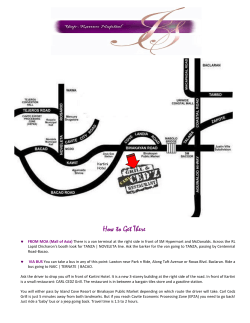
itxpt-driving-forward-interoperability-mobility
3/18/2015 ITxPT DRIVING FORWARD INTEROPERABILITY | Mobility Magazine ITXPT – DRIVING FORWARD INTEROPERABILITY The mission of the ITxPT (Information Technology for Public Transport) initiative, active since June 2013, is to support the deployment of standards and practices for onboard, plugandplay ITS, together with the relevant back office features. By Lesley Brown Given the heterogeneous nature of collective transport networks from country to country, the organisation of IT architectures and data communication is highly complex. And this complexity is hampering the success of the sector in today’s highly competitive context. Yet if public modes are to maintain (and gain) market share, they need IT systems that are interoperable – both within the IT architectures themselves and between the different public transport stakeholders operating on the same territory. The ITxPT consortium (see below) carries forward the results of the European Bus System of the Future (EBSF) project. The latter, which ran from 2008 to 2012, developed an EBSF IT architecture based on open technology. This integrated platform enables operators and organising authorities to use public transport data anywhere in Europe through common mechanisms, standard rules and protocols. By connecting all information systems (urban, suburban, regional, or national transport networks), realtime, multimodal passenger information is made possible at European level, and new transport services can be developed infinitely. ITxPT members Founding : Actia, Cofely Ineo, Digimobee, Dilax, Init, Iveco, Pilotfish, UITP, Volvo Strategic: Card4B Systems Principal: Dilax, Keolis, Thales, Transdev, Transport for London (TfL) TESTING PRIOR TO DEPLOYMENT The ITxPT integrated platform enables suppliers to test their IT modules in real operational conditions, and to validate their compliancy with the parts 7/8/9 of standard EN 13149.* It also allows public transport authorities and operators to test their own IT architecture before deploying it on their fleets. By limiting risks during the integration stage, these tests will facilitate rollout on the ground. data:text/html;charset=utf8,%3Ch2%20style%3D%22margin%3A%2016px%200px%3B%20padding%3A%2011px%2030px%208px%209px%3B%20bord… 1/4 3/18/2015 ITxPT DRIVING FORWARD INTEROPERABILITY | Mobility Magazine WINNING FORMULA The use of the EBSF standard interfaces and protocols, driven by ITxPT, is expected to reduce the costs of investment, operations, and maintenance, as well as allowing for scalability. In turn, these benefits should make public transport more costeffective and interoperable than is currently the case through existing solutions on the market. The specific wins are as follows: no more time and money wasted on developing specific interfaces tenders can be open to more competitors thus helping to obtain better prices no more money wasted on redundant equipment: bus equipment (driver terminal, gateway, GPS …) and infrastructures (stop signs, fleet management control …) share the same architecture no more need to change the whole system when specific equipment needs to be changed plug and play integration of the new applications and IT devices facilitate installation and onboard maintenance operation costs are reduced through the integration of multimodal information systems that allows to better plan urban and regional transports and to optimise connections between all modes and operators as well as to take efficient actions in case of incidents Time and money can be now invested in new and innovative applications! PASSING THE BATON Traffic congestion and pollution are significantly damaging the quality of life in modern cities. Combined with climate change, these factors dictate major improvements in public transportation. Buses, in particular, account for 80% of shared transit journeys across the globe, with 30 billion people using them every year to travel in cities throughout Europe. Yet despite its importance, the mode is still struggling to shake off its image as ‘the poor man’s limo’. The EBSF enterprise already achieved advances in terms of vehicle design, infrastructure, and operations. Now it has passed the baton to ITxPT – the world’s first consortium dedicated to plugandplay ITS for the public transport domain. In this unique capacity, the initiative is set to continue this progress towards boosting the appeal and ridership of buses, and collective transport in general. For more information on ITxPT, please visit www.itxpt.org, or contact Pauline Bruge at pauline.bruge@uitp.org *‘Public transport. Road vehicle scheduling and control systems. WORLDFIP definition and application rules for onboarddata transmission’ The Intelligent, Innovative, Integrated Bus Systems project (3iBS) complements the work led by ITxPT by conceiving the guidelines supporting PTO, PTA and industry suppliers in deploying the IT plugandplay standard in bus fleets. Led by the UITP from October 2012 to March 2015, the action brings together 10 partners plus over 60 associated partners. By capitalising on the results of EBSF and other bus system projects, 3iBS is committed to stimulating research, exploiting bus system innovations, supporting the deployment and implementation of key solutions, and exchanging knowledge on an international scale. data:text/html;charset=utf8,%3Ch2%20style%3D%22margin%3A%2016px%200px%3B%20padding%3A%2011px%2030px%208px%209px%3B%20bord… 2/4 3/18/2015 ITxPT DRIVING FORWARD INTEROPERABILITY | Mobility Magazine PUSHING FORWARD INIT, the supplier of integrated Planning, Dispatching, ITS and Fare Collection suppliers is one of the nine founding members of ITxPT. It was also active in the EBSF project, and is involved in 3iBS. Mobility spoke with Dirk Weißer, project manager research, to find out more about the company’s role(s) in helping make full interoperability of IT systems in PT applications a reality. When did ITxPT officially kick off? And how long will it run? The official start meeting took place on June 13, 2013. Over the next 12 months, subsequent activities included preparing the consortium agreement (including establishing its status as a nonprofit organisation), clarifying the overall financial aspects, and drawing up a marketing strategy. Also, as part of the latter, we have presented/showcased the EBSF test bench(es) [see below] together with ITxPT at trade shows such as IT TRANS (Karlsruhe), Transports Publics (Paris), and the 10th ITS European Congress in Helsinki. With regards the duration of ITxPT, there is no end date in view; it will last as long as the consortium works together well. The EBSF IT architecture is integrated into two test benches conveniently located at the ECE Paris engineering school. Coordinated by the ITxPT consortium, access is practically open for everyone, subject to a fee dependent of the user’s membership status. The benches, which represent the onboard and back office architecture of the bus system, offer services to specify, test, qualify and showcase IT solutions. How was INIT occupied in the EBSF and 3iBS initiatives? We participated in two EBSF work groups – one focusing on the communication architecture on board vehicles, and another dedicated to the communication between several back offices and the vehicle. We also part of the IT Focus Group of 3iBS. Why was this ITxPT followup activity deemed necessary? The idea behind ITxPT is to create a consortium, funded by its industry members, to push forward the IT architecture developed by the EBSF. As a complete ITS system provider, INIT offers its customers a panoply of IT solutions for public transport. However, unless implementing a brand new system from scratch, we are not starting out in virgin territory, but have to integrate our systems with existing infrastructure interfaces. And this multifaceted task – integrating systems with the onboard units of different competitors, and different generations too, all on the same vehicle fleet – requires a considerable effort, as well as costing time and money. The platform is based on ‘open architecture’. Why is this feature so crucial? A closed system basically means one equipment supplier and one system. Open architectures allow for multiple device vendors, and so should create healthier competition for public transit vehicle builders and operators by offering them choice. Furthermore, since open systems embrace plugandplay, the latter can be kept up to date, in line with changing needs and technologies. At INIT we have brilliant developers, but rather than evolving five different interfaces it’s far more intelligent for them to focus on just one, and make it work really well. This in turn frees them up to concentrate more on innovation – for the benefit of ourselves at INIT, our customers, transport operators, and even the endusers, the passengers themselves. data:text/html;charset=utf8,%3Ch2%20style%3D%22margin%3A%2016px%200px%3B%20padding%3A%2011px%2030px%208px%209px%3B%20bord… 3/4 3/18/2015 ITxPT DRIVING FORWARD INTEROPERABILITY | Mobility Magazine The key function of ITxPT is to act as a technical platform for testing and validating the plugandplay IT systems developed. Why is plugandplay so essential? It’s all about making time and cost savings by removing the need to configure new systems when adding them to a vehicle, i.e. along the same principle as slotting a memory stick into a computer to instantly access its content. Plugandplay integrate public transport, and share information sent by all stakeholders involved in the bus journey. At INIT, when we have a new customer, a new project, our first step is to check all the existing hardware, to examine the plugs and cabling on board to find out if we can use them as they are, what we will have to adjust, etc. And the hardware is never plugandplay. In other words, we have to develop, install, test, and adjust. This process takes a lot of time, effort, and, of course, costs money. What trends are you seeing in ITS in the public transport world at large? In everyday life, outside of public transport, IT systems are becoming increasingly the norm. For example, a decade ago, touch interfaces were very rare, or unusual, as were smartphones. Then came the iPhone, since when the touch interface has become a musthave. However in public transport, touch screens and smartphones, for example, are developing more for passenger orientated applications, e.g. information, ticketing, etc. They serve to create points of contact with passengers, to align the sector with their everyday habits as citizens of today’s digital world. Having said that, at the professional end of public transport, i.e. back offices, management and operations, the traditional way of doing things with a ‘normal’ desktop computer and keyboard still exist, simply because the interface is more practical, e.g. for filing a report on a traffic incident, and so forth. The modularity of onboard equipment is very important to our customers. What they want is easy integration of equipment from supplier A, supplier B, & supplier C. How is business for INIT? Has the recession made an impact? Overall, I would say the economic downturn hasn’t had a marked effect on our enterprise because we are active across the globe, e.g. from Nottingham (U.K.) and Avignon (France) to the United Arab Emirates (UAE). There are always ups and downs in markets at any given time. A new development for us in recent years has been the ticketing segment for public transport in North America. This is quite surprising because the systems used to be rudimentary. But for some reason they are now adopting e and mobile ticketing. So this market is really growing for us, as is Asia, where we are interested in developing business. data:text/html;charset=utf8,%3Ch2%20style%3D%22margin%3A%2016px%200px%3B%20padding%3A%2011px%2030px%208px%209px%3B%20bord… 4/4
© Copyright 2025











